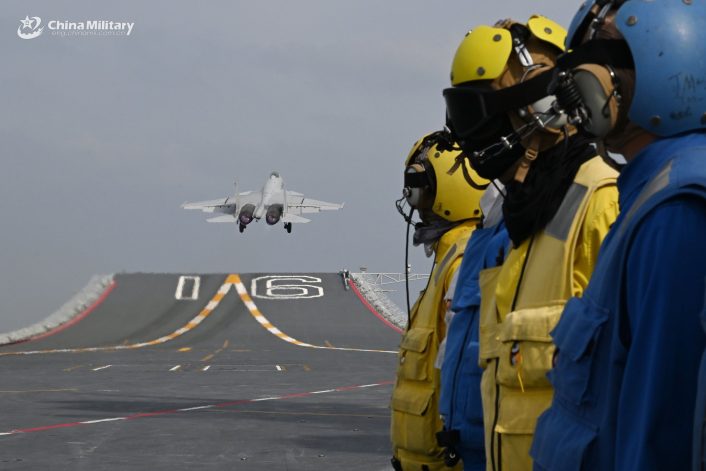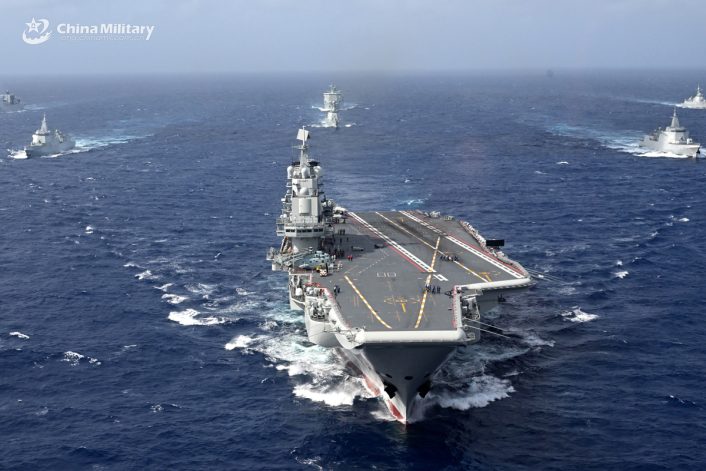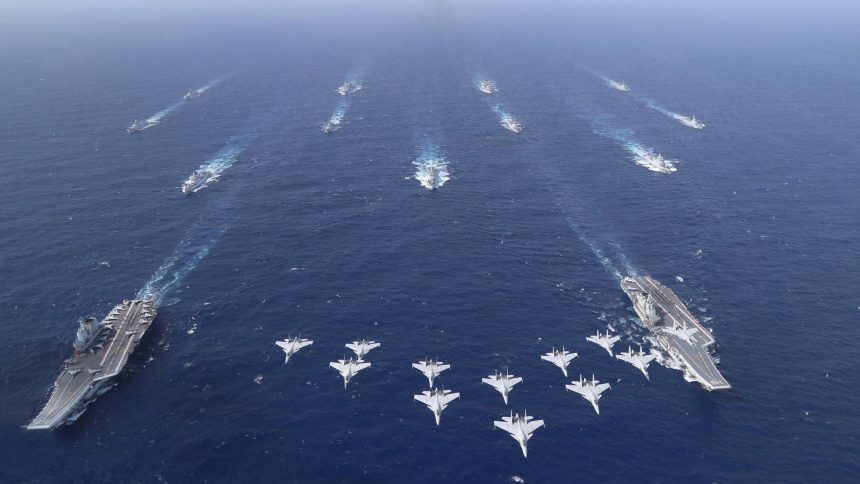The dual carrier exercise, which involved for the first time the new CATOBAR variant of the J-15, was part of the PLA Navy’s annual training plan and aimed at improving the carrier strike groups’ systematic combat strength.
For the first time, the PLA Navy conducted a dual-carrier exercise with the Liaoning and Shandong aircraft carriers in the SCS (South China Sea) in the concluding days of October 2024, the Chinese military announced. The PLAN released images of a massive armada of 13 ships, including the two carriers, and 12 J-15 carrier-borne jets flying overhead. The other ships included three Type 55 destroyers, three Type 52D destroyers, three Type 54A frigates and two fleet replenishment tankers.
The MND (Ministry of National Defense) spokesperson Senior Colonel Zhang Xiaogong said at a news briefing on Oct. 31 that the “two-carrier” exercise was a part of the Navy’s “annual training plan and aimed at improving the carrier strike groups’ systematic combat strength.”
The Liaoning CSG (Carrier Strike Group) had been operating in the SCS since Sep. 17-18. The vessel, from Sep. 27 to Oct. 1, clocked approximately 130 take-offs and landings by carrier-based aircraft and around 90 helicopter operations. This totalled 220 take-offs and landings in the four-five day period.
China Military Online, the PLA’s official website, said that the drill took place in the middle of a “long distance” exercise by the CNS Liaoning CSG, that sailed across the Yellow, ECS (East China Sea) and the SCS from September to October. Liaoning was joined by the CNS Shandong CSG after it arrived in the SCS.
Chinese #PLA Navy’s aircraft carriers #Liaoning and #Shandong carry out a dual-aircraft-carrier formation drill for the first time in the South China Sea in late October. #Chinesenavy #aircraftcarrier https://t.co/HKbOh3aVKY pic.twitter.com/OahQlxXhmh
— China Bugle 中国军号 (@ChinaBugle) October 31, 2024
The Liaoning group then returned to its homeport at Qingdao Province in Shandong, with the Shandong strike force still presumably in the region. We can expect this formation to continue exercises in the region between the southern part of the ECS and the SCS over this month.
The Shandong is the PLAN’s second aircraft carrier and, like the Liaoning, is a STOBAR (Short Take-Off Barrier Arrested) configured vessel. China’s third carrier, the Fujian, is a regular flat-top, with EMALS (Electromagnetic Aircraft Launch System) catapults which allow operations with CATOBAR (Catapult Assisted Take Off Barrier Arrested Recovery) aircraft.

The exercise
The latest drills were centered around the Liaoning, according to Xinhua, aimed at “real combat training in the high-seas.” The drills featured “multiple subjects under real-combat circumstances.” The stress on realistic combat scenarios has been a distinctive description ascribed to China’s formation and command-level exercises.
This first began appearing around 2018 in President Xi Jinping’s exhortation to the Chinese military to “strengthen real combat training and improve its war-winning capability.” It was later repeated during subsequent drills when the PLA was in the middle of a standoff with the Indian military in eastern Ladakh, at the height of the military tensions between China and its Himalayan neighbor.
Looks like there are a further 6x J-15Bs on Shandong’s deck (again, identified primarily via lighter radome colour which is handily contrasted with J-15A dark grey radomes on the same flight deck)
I.e.: ?total 15x J-15Bs in this pic…
Maybe a few more below deck + on shore…? https://t.co/H5wJnKQO5K pic.twitter.com/9WOg1dZj6U
— Rick Joe (@RickJoe_PLA) October 31, 2024
Xi’s message to troops to exercise in “realistic combat scenarios” also came during a period that also saw simultaneous strategic tensions with the United States in the western Pacific. It can however be taken as a dramatic expression conveying war-readiness and deterrence signaling to the U.S.-led alliance. All militaries have significant elements in their drills that represent actual war-like operational and tactical scenarios.
Videos released by China Bugle, the official handle of the PLA News Media Center, showed J-15s taking off, a Harbin Z-9 naval multirole utility helicopter landing on the deck of what could possibly be the Type 054A frigate Huangshan. The Huangshan and a Type 055 destroyer Dalian also received mid-sea refueling from the Type 903A supply ship Loumau. The refueling can be assumed to have taken place the same day as the carriers sailed together alongside.
The J-15B CATOBAR Flanker
In the photos, the Shandong is seen carrying a complement of 18 J-15s, with possibly more below the deck and none seen on the Liaoning. This could mean that the 12 J-15s flying overhead are from the CNS Shandong.
Leading Chinese military researcher Andreas Rupprecht, however, noted an interesting detail, as the J-15s appear to be the new ‘B’ variant, the CATOBAR J-15B developed specifically to operate from the Fujian carrier. The new variant, in fact, has been equipped with a beefed-up nose landing gear and a launch bar to be able to operate from catapult-equipped carriers.
Another distinguishing feature from the older J-15, which allows the J-15B to be recognized in these new photos, is the absence of a coloured nose cone, as the aircraft is now featuring an all-gray paint scheme. However, two J-15s flying in the formation sport the darker nose cone, so the aircraft in flight could be a mix of J-15As and J-15Bs. A mix of both variants can also be seen on the Shandong, with at least six J-15Bs.
A first: Chinese PLA Navy conducted its first-ever dual-carrier formation exercises in the South China Sea, featuring both the Liaoning and Shandong aircraft carriers. pic.twitter.com/93qvKFivq3
— Clash Report (@clashreport) October 31, 2024
The J-15 is a heavily reverse engineered and modified Chinese derivative of the Russian carrier-borne Su-33 fighter, and like the Su-30 jet, sports front swept-back canards below the cockpit. This was also the jet that a Taiwanese F-16V captured on its Sniper ATP (Advanced Targeting Pod), when China launched the Joint Sword-202B exercises around Taiwan in mid-October.

Goals of the exercise
The primary military goal is to refine its sailors’ and pilots’ ability to operate in punishing environments of carrier-borne naval aviation and bring their skills on par with western navies. A political intent is to signal China’s growing military capabilities in its waters to the U.S. and militarily assert its territorial goals. Dual-carrier exercises, however, also embody a specific maritime goal, since the U.S Navy too has conducted drills with two aircraft carriers in the past in the western Pacific.
Finally we got confirmation, that the modernised J-15B is in PLAN Naval Aviation service.
This in fact is not surprising since within the recent months we already got some hints and blurry images suggesting it to be, but to finally see in in numbers is a pleasant surprise. https://t.co/HlDVZHGBkG pic.twitter.com/BMR7BJrI1b
— @Rupprecht_A (@RupprechtDeino) October 31, 2024
In Feb. 2021, the USS Theodore Roosevel and USS Nimitz CSGs together held exercises near Chinese-controlled islands in the SCS. The U.S. Navy said at the time: “The CSGs conducted a multitude of exercises aimed at increasing interoperability between assets as well as command and control capabilities.” This was the second dual-carrier operation in the contentious waters since Jul. 2020 according to Reuters.
During the 2021 drills, USNI said the USN “did not see any abnormal responses from China,” when the exercise was underway. The report quoted the commander of the Carrier Strike Group 9, Rear Admiral Doug Verissimo: “We didn’t see anything significantly out of the norm with our two carriers coming together for this rendezvous.” Beijing is therefore demonstrating its Navy’s ability to operate like the U.S. Navy.









